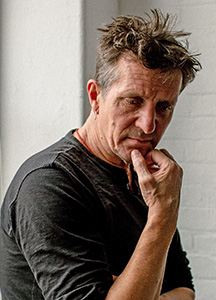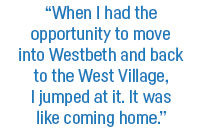 Painter Stephen Hall was born in Aberdeen, Scotland in 1954. A resident of Westbeth, Hall has exhibited throughout the U.S., India, Japan, Korea, and Mexico. His work is part of numerous corporate and private collections and has been featured in major motion pictures, music videos, and magazines.
Painter Stephen Hall was born in Aberdeen, Scotland in 1954. A resident of Westbeth, Hall has exhibited throughout the U.S., India, Japan, Korea, and Mexico. His work is part of numerous corporate and private collections and has been featured in major motion pictures, music videos, and magazines.
“I always had this drive to draw and paint,” says artist Stephen Hall. “I was never not doing that. According to my mother I was drawing behind the couch by the age of three or four. And I’m completely self-taught. I was actually very lucky, as well. I grew up in a council estate but thanks to the Eleven-plus exams, I was taken out of my working class school and sent to Aberdeen Grammar School, founded in the 14th Century. I was always a bit of a maverick, even back then, but the art teachers at the school were very encouraging to me. And my parents were always very supportive.”
Hall admits that he didn’t really become an artist until moving to New York in 1978. That was after hitchhiking around the world when he was about 19 and deciding he didn’t want to return home. “I had seen a lot of the world and Aberdeen was too small a town for me,” he says. “No offense to small towns, but I was looking for more. At one point I was working on a kibbutz in Israel. While I was there, I met a girl from New York and I came back with her and I eventually started exhibiting and selling my work. I’ve been here ever since.”
What is Hall’s preferred medium? “Acrylics,” he answers. “They’re the easiest and cleanest for me. I never had the patience for oil, the drying times. I believe, especially now, that oil is just a vehicle to move the pigments. And with acrylic you can make just as superior a painting as the classic oil painting. As far as my style goes, I think there’s always been a recognizable vocabulary as being mine: a crisp color sense and graphic skill.”
“I’m endeavoring to be more specific and less ambiguous in my work,” he continues. “I still want to make beautiful, well-crafted paintings that aren’t elitist and stimulate thinking. With my new series called Earth Matters—prompted by climate change—I’m fully up to my eyes in three-dimensional backgrounds of plastic, garbage, and rising sea levels. They get more and more complicated and harder to do. I often wish I was an Abstract Expressionist and could just throw paint on the canvas!” He laughs. “My paintings are meticulous and time-consuming. But doing the work is what drives me. Quite literally, the time I’m not painting is when I catch the flu or a cold. My resistance drops and my energy level drops. That’s because I’m driven to paint. I’ve got no choice.”
What has the life of an artist been like for Hall? “It’s been like a wave that ebbs and flows,” he says. “I’ve had times of great success and having patrons, and times when I didn’t sell much work. I never became super famous—although I was big in Japan at one point—but I do sell all my work.” And as an artist, living in Westbeth has proven to be a “fantastic haven” for Hall as well. “Westbeth was set up to provide support for artists and it actually does that”, he says. “For the 22 years I’ve been here it has seen me through some lean times. A lot of artists have had to move out of the city or get a corporate job, but I haven’t due to the support of Westbeth.”
 The neighborhood has certainly changed, though. “There used to be transvestite hookers outside the building here,” Hall says. “It was very cinematic. I enjoyed it. It’s a bit more shopping mall now but I appreciate that since I have a thirteen-year old daughter who’s always coming and going. Years ago, I had the good fortune to move to Bleecker Street between Charles and Tenth. It was my first apartment in the West Village and I fell in love with it. It was like a village. The streets weren’t gridded, there was still a hint of Bohemia, and it was pretty and quiet. When we lost that apartment and moved to the East Village, I loved that too: it was raw, gritty, and arty. But when I had the opportunity to move into Westbeth and back to the West Village, I jumped at it. It was like coming home.”
The neighborhood has certainly changed, though. “There used to be transvestite hookers outside the building here,” Hall says. “It was very cinematic. I enjoyed it. It’s a bit more shopping mall now but I appreciate that since I have a thirteen-year old daughter who’s always coming and going. Years ago, I had the good fortune to move to Bleecker Street between Charles and Tenth. It was my first apartment in the West Village and I fell in love with it. It was like a village. The streets weren’t gridded, there was still a hint of Bohemia, and it was pretty and quiet. When we lost that apartment and moved to the East Village, I loved that too: it was raw, gritty, and arty. But when I had the opportunity to move into Westbeth and back to the West Village, I jumped at it. It was like coming home.”
Photo: Gabriel Flores
